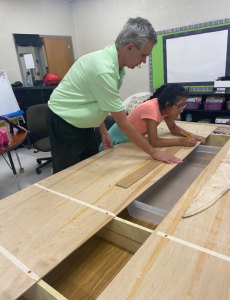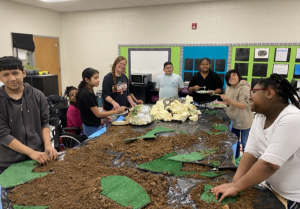Innovative STEM projects are more than a lesson plan. Jim Franklin, a special education teacher from Elm Street Elementary in Rome, GA, has developed a unique project to meet the needs of his students in his 5th and 6th grade special education resource classroom. The project began in mid-August and continued throughout the 2023-24 school year. With the guidance of their teacher, students designed and built a “living” table that has had a variety of themes, such as a mountain village, “Polar Express,” Iwo Jima, and spring incentives.

Jim developed weekly lesson plans that address numerous grade-level standards and review foundational concepts that have not been mastered by his students in previous grade levels. He also provided non-traditional learning opportunities for students to master their Individual Education Plans’ goals and objectives in math, writing, and reading. It is important to note that accommodations and modifications were implemented in the lessons. Here is an overview of the “living” table –
Math:
For the first 15 minutes of a 45-minute math class segment, the students enlarged a 4’ x 6’ table by building a 6′ x 8’ raised platform to place on top of it. To create this part of the project, the students were reintroduced to the standards of area and perimeter, measurement, money, elapsed time, all four math operations, and fractions. After modeling how to safely use a drill, tape measure, hammer, and electric sander, the teacher used close proximity to give all of his students multiple opportunities to use the tools. All of the boards’ measurements were conducted by the students, verified by their teacher, and then cut by the teacher for safety reasons. For the remaining 30 minutes of class, the students worked on math fact fluency skills and math reasoning problems.
ELA:

In ELA, the students were expected to summarize the progress of the project on a daily basis by planning, writing a draft, revising and editing, and publishing a paragraph by typing it in their Chromebooks. Students also had to put the steps of building the project for the day in chronological order by incorporating transition words.
It is important to note that some of the students have had a history of being quite reluctant to write. All of the students were made aware that if they did not publish their paragraph for the day, they would only be able to observe the building of the project the next day.
Science:
The students grew cilantro by planting seeds and watering them. The purpose of growing the cilantro was to use it to make homemade salsa. When the salsa was made in class, students used different units of measurement to measure the ingredients. They also learned the importance of planting a garden and growing their own food, if possible.
The students experimented with mixing primary colors to create varying shades of colors. Then, they painted the project’s mountain with the colors to make the project look as realistic as possible.
The students also learned how to install a pump that can circulate water in the display’s “lake.”
Speaking:
Every student was assigned one part of the project, wrote a paragraph and then shared and demonstrated the steps in how it was built to a visiting classroom.
During the “March 2024 Family STEM Night” at Elm Street Elementary, the students spoke to parents, their siblings, and other students about their roles in designing and building the various parts of the project.
Social Studies/ Reading:

The students researched the shape of Iwo Jima and then had to modify the platform to make it the shape of the island. They also had to research the historical significance of the battle, learn the geographic location of the island in the Pacific Ocean, and proximity to the United States.
The teacher introduced the game Battleship to his students. Then, he modeled how to play as well as the game’s objectives. After placing the American and Japanese soldiers on the Iwo Jima display and then selecting points on the game’s coordinate plane, the class was divided into two teams and began to play “Iwo Jima” by using the concepts and rules from the Battleship game. The students were being exposed to grade-level social studies and math standards simultaneously as well as appropriate game etiquette.
The students learned the branches of the United States Military and its role in the battle, specifically, and other battles during World War II. At the end of the game, the teacher played a rendition of “Taps” on the Smartboard with the students standing quietly beside their desks with their hands on their hearts to honor our country’s soldiers.
Life Skills:
The students learned home improvement skills, such as painting, using tools, and planning a project. They were also exposed to situations that were not assessed on assessments; they had to exhibit patience during problem-solving tasks, take turns, work as a team, and be flexible if something needed did not work the first time to complete or new plans were required.
The students in this class exhibited growth on their 2023-24 MAP Assessments and progress toward mastery of their IEP goals and objectives. The most important outcomes of the “living” table were the positive relationships and memories that were built in the classroom.
Behavior Incentives:
The “Living Table” was transformed into an incentive table three weeks prior to Easter. The eggs had a different piece of candy inside of them as well as other kinds of rewards, such as a $1.00 bill, “10 minutes of game time” and “10 minutes of free time.” In order for the students to pick an egg, they had to complete all of their work and demonstrate appropriate behavior to their teacher and peers.
For additional information regarding the “Living Table,” Jim can be contacted at Slide-A-Round@comcast.net.
Resources
Please login or register to claim PGPs.
Alternatively, you may use the PGP Request Form if you prefer to not register an account.



